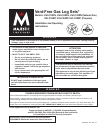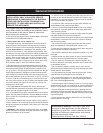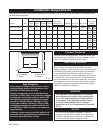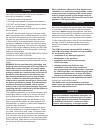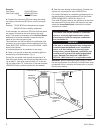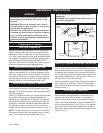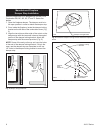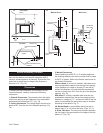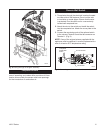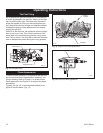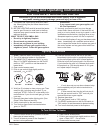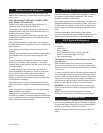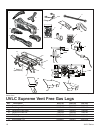
2 UVLC Series
General Information
IN ORDER TO ASSURE A SAFE AND EFFECTIVE
INSTALLATION, ONLY A QUALIFIED SERVICE
PERSON WHO IS FAMILIAR WITH THE BUILDING
CODES AND INSTALLATION TECHNIQUES AP
-
PROPRIATE TO YOUR AREA MAY INSTALL AND
SERVICE THIS APPLIANCE.
• In order to avoid any possible gas leaks, apply pipe joint com-
pound to all non-flared, threaded connections involved in this
installation. For propane, the joint compound must be resistant
to the corrosive action of propane.
• To check for leaks, always use a soapy water solution or a
sniffer. Never test by using an open flame.
• The area around the gas logset must be free of all combus-
tible materials, especially gasoline or other highly flammable,
vapor producing liquids.
• Due to high temperatures, locate this logset away from both
high traffic areas and furniture and draperies.
• Children and adults alike should be aware of the high surface
temperatures; to avoid the risk of burns or ignition of clothing
they should stay away.
• Do not touch any part of the logset other than the controls
while it is operating or immediately after you turn it off.
• Supervise young children and pets carefully when they are in
the room where the logset is operating.
• Do not place clothing or other flammable material on or near
the logset.
• Make sure that any safety screen or guard, removed during
servicing, has been replaced before you use the logset.
• Do not, under any circumstances, install the logset in any
bedroom, bathroom, other small, enclosed room, mobile home
or recreational vehicle.
• Do not install the logset in a drafty area or use it with any
after-market blower system that may cause drafting and conse-
quently alter the flame pattern.
• It is imperative that you keep clear all burner areas, control
compartments and passageways for circulating air.
• Do not move the logset in any way that might dislodge the
logs from their fixed positions. If you bump the logset check to
see if you have dislodged anything.
• Vent-free logsets require additional fresh air. You may supply
additional fresh air with any combination of: opening windows or
doors; or by operating a central furnace blower or exhaust fan.
• Provide adequate clearances around air openings into the
combustion chamber and adequate accessibility clearance for
servicing and proper operation. NEVER obstruct the front open-
ing of the fireplace.
• Avoid propane tank dropping below 25% full. This will help
prevent soot from occurring.
The Logsets have been designed and tested to operate
safely when installed according to the installation instruc-
tions contained in this manual. Read all instructions
before starting the installation.
• The vent-free gas logset must be installed only in a fireplace
constructed of noncombustible material.
• These logsets are not for exterior use.
• The logset should be inspected before use and at least an-
nually thereafter. More frequent cleaning may be necessary
because of excessive lint from carpeting or bedding material.
• In the United States, the installation and operation must
conform to local codes or, in the absence of local codes, with
the National Fuel Gas Code, ANSI Z223.1/NFPA 54, latest edi
-
tion and with the National Electrical Code, ANSI/NFPA70 (latest
edition). State or local codes may only allow operation of this
appliance in a vented configuration. Check your state or local
codes. In Canada check local province for proper use or CSA-
B149. Refer to pages 7 and 8 for installation details.
• The gas logset and its individual shutoff valve must be dis-
connected from the gas supply piping system during any pres-
sure testing of that system at test pressures in excess of 1/2
p.s.i.g. (3.5 kPa.) The gas logset must be isolated from the gas
supply piping system by closing its individual manual shutoff
valve during any pressure testing of the gas supply piping sys-
tem at test pressures equal to or less than 1/2 p.s.i.g. (3.5 kPa.)
• Do not, under any circumstances, burn solid fuel (wood, pa-
per, coal) in the masonry or UL127 factory built fireplace where
you have installed your logset. Do not use it for cooking. Put
nothing on top of the logs.
• The logset must be compatible with its fuel. Natural gas
requires different hardware than propane. Never attempt to use
natural gas with a propane logset or vice versa.
• For a propane burning logset, the supply tank must include a
high to low gas pressure regulator. The tank must be outdoors.
Do not, under any circumstances, locate supply tanks inside
any structure.
• The fireplace must include a screen made of chain mesh or
a similar material. You must keep the screen closed at all times
during the operation of the logset; it will protect you in the event
of an explosion.
• WARNING: If the fireplace contains glass doors, they must
remain fully open at all times during the operation of the logset,
allowing combustion air to circulate.
Proposition 65 Warning:
Fuels used in gas, wood-
burning or oil fired appliances, and the products of
combustion of such fuels, contain chemicals known to
the State of California to cause cancer, birth defects
and other reproductive harm.
California Health & Safety Code Sec. 25249.6



